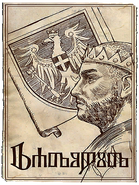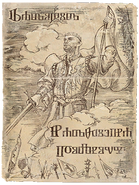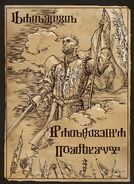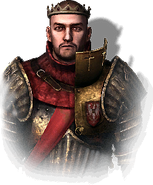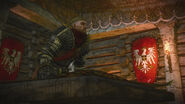- Main
- Netflix series
| They say it's the game of kings. That chess teaches one to think strategically. What a load of rubbish!... Both sides have identical pieces, the rules stay invariably the same. How does this mirror real life? | |||
| - Radovid discussing politics, The Witcher 3: Wild Hunt | |||
Radovid V the Stern (Polish: Radowid V Srogi) was the king of Redania and a member of the Redanian Dynasty in the last quarter of the 13th century.[2] Even though his father, King Vizimir II, was assassinated in 1267, Prince Radovid didn't succeed him immediately because he was only twelve at the time and for several years the kingdom was governed by a Regency Council, under the influence of Duke Nitert and Count Sigismund Dijkstra, the then-spymaster of the Redanian Secret Service.[3][4] His reign became, along with the witch hunts, one of the defining factors of the post-war period that followed the Peace of Cintra. Radovid was a polarizing figure: a brilliant strategist and a superb general to some, a paranoid madman to others. There were also many who took the middle view of his policies being harsh but justified.[5]
Quick Answers

What is the significance of Radovid the Stern's reign in the post-war period?

What is the role of Radovid V as the king of Redania?

What are the defining factors of Radovid V's reign?

How does Radovid V's reign impact the storyline of The Witcher 3?

Biography
Early life
Radovid was born in 1255 in Tretogor to King Vizimir II and Queen Hedwig of Malleore, as their third child and firstborn son, making him by default the expected heir. His two older sisters were Dalimira and Milena.
When Radovid was 9 years old he was formally engaged to the 12 year old Cirilla, Princess of Cintra. The engagement was formalized between his father and Queen Calanthe, Ciri's grandmother, but the king broke the engagement off after half a year without giving any explanation and Ciri and Radovid never even had a chance to talk to each other.[6][N 3]
Regency years
On the day of the outbreak of the Second Northern War with the Nilfgaardian Empire, his father had unexpectedly fallen victim to an elven assassin.[3] A fact unknown to practically anyone was that it was Philippa Eilhart, at the time fighting on Thanedd Island, who hired the elf in order to gain more direct rule.[N 4] Redania fell into chaos, as usually happens in such circumstances, and Queen Hedwig was not in a state to control things.[N 4] The aristocracy started to organize itself into factions, attempting to tear some land out for each and every one of them. Several practically licked the boots of Nilfgaardian emissaries led by Shilard Fitz-Oesterlen and were ready to rule with Nilfgaardian blessing, only to be caught off guard and stopped by the famous Redanian Secret Service. There remained but a handful of those who were spared, those with important enough social status and armed might to maintain peace, like Duke Nitert.
Nitert was put in charge of the Regency Council appointed to save the realm from a total civil war and they (particularly Dijkstra) managed to do so, by hanging everyone they deemed traitor in specially modified fortifications with internment camps (most infamous of which would be Drakenborg).
During a parade in Novigrad that followed the Peace of Cintra in 1268, young Radovid, now 13, lamented the fact that the Regency Council and the Northern Kingdom's elites had completely dismissed his mother's presence as well as his own during the celebrations, and made no mention of his father's contributions to the alliance, either. While he was seen at that time as a person of no significance in a country ruled by the Regency Council, he swore in his thoughts that in time, he would show them otherwise. Philippa Eilhart, Redania's court sorceress, sensed something in the boy that very moment.[2]
Philippa later took it on herself to became Radovid's tutor.[7] Not only was she a strict teacher who dominated and demeaned the boy throughout his youth despite him believing her every word[8][9] – having bribed or coerced the kingdom's elites, Philippa pulled strings from behind Radovid's back, effectively ruling in his name.[7][8] Radovid would later recall, exaggerating, how the entire Redania laughed behind his back,[8] whereas others would tell scary tales regarding the Prince's upbringing.[9] What is certain is that Philippa taught Radovid to look everyone in the eyes in a way that would force them to lower their eyes, and that the king must never show weakness or uncertainty;[8] her harsh methods severely impacted young man's character.[9]
Beginnings of reign
Radovid V began his reign by taking care of various nobles who ruled on their lands rather independently from Tretogor. He proved a capable political actor, manipulating events to the advantage of both his own position and Redania's. He utilized Redania's spy network to foster links with multiple potential allies, picking and choosing as he saw fit while ensuring those discarded were destroyed. In all his political actions, he attempted to embody the idea that a king should be ruthless towards his foes and generous to his friends.[9]
Time in Vizima
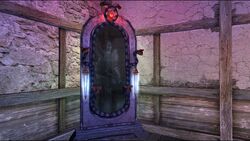
Looking to secure relations with Temeria, Radovid made his way to the kingdom's capital of Vizima in 1270. However, while there he eventually came into contact with Salamandra through some "mutual acquaintances" and thought he could make use of the criminal organization but ultimately concluded not to do so. Despite this, the witcher Geralt of Rivia happened across some of the criminals communicating via a mirror with the king, who only revealed he wasn't backing the group before closing off communications with the witcher.[7]
Eventually, though, his hideout was discovered by the witcher. The two conversed for a bit, with Radovid revealing why he was in Vizima before asking the witcher's opinion on Adda the White, who he was seeing as a possible way to combine the two royal families. The two then parted ways.
- If Geralt saves Adda: With Adda's curse lifted once more, Radovid then proceeded to marry her to solidify the two kingdoms' union.
- If Geralt doesn't save Adda: With no other way to combine the two kingdoms, Radovid returned to Redania to reign over by himself.
Consolidating his power
Back from Temeria, Radovid V began to gather his armies and erect fortresses. To counter the sorceresses' rising power, he invited the Order of the Flaming Rose to Redania and granted them lands.[8] He made several military reforms, espousing the idea that a soldier was only as good as their breastplate. He ensured that his armies were well-equipped, allowing his quartermasters as much gold as was needed to keep his infantry in solid armor. Aware that human soldiers were neither as strong as dwarves nor as dexterous as elves, identified their key advantage: their numbers. A mass of humans, led by a capable of commander, could overwhelm an individually superior force. His final military philosophy concerned the effectiveness of heavy cavalry, and he would suggest that any battlefield problem could be overcome by a gallant charge. These tactics would see him through several successful military campaigns, culminating in a subjugating nearly the entirety of the Northern Kingdoms and the defeat of the invading Nilfgaardian forces of Emhyr var Emreis' third invasion.[9]
In July 1271, Radovid came to the deliberations at Loc Muinne, followed by a number of regular soldiers and knights of the Flaming Rose who were meant to ensure that peace talks remained peaceful, as well as step in if things did not go Redania's way. Shortly after arriving, the King imprisoned Philippa Eilhart with the help of Nilfgaardian delegation. To avenge his father, he had her eyes gouged out and meant to execute her before she escaped.[8]
Third Northern War and further life
When the Third Northern War broke out, Radovid remained the only monarch to have the strength to resist Nilfgaard. Taking advantage of this, during the winter break, he invaded a weakened Kaedwen and absorbed the Kaedwenian Army into his own. He also had Temerian partisans[5] and Kovirian mercenary companies at his disposal,[10] and considered utilizing the Crescent Moon, an influential independence movement in the Nilfgaard-conquered Nazair.[11]
However, both Radovid and Emhyr had set their eyes on Novigrad, as whoever controlled the free city would not only have control over the ports, but its hefty treasury as well, therefore making victory likely for the one who gained control of it. To try and weaken the city for his taking, Radovid employed the services of Whoreson Junior, one of the "Big Four" of Novigrad's underground crime bosses, enticing him with money and a grand estate in Oxenfurt in return for turning on the other bosses and bringing about their downfall.
His plan worked to a degree, but once it was clear that Junior had outlived his usefulness, Radovid decided to reveal his location to Geralt - who sought revenge on Whoreson Junior for unrelated reasons. However, Radovid took advantage of this and called upon Geralt for a favour; while onboard his flagship, the HMS Oxenfurt-Tretogor, Radovid asked the witcher for his help in finding and apprehending Philippa Eilhart.
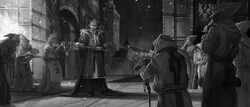
In the end, Radovid managed to defeat the invading Nilfgaardian forces, winning the Third Northern War. With this victory, Radovid absorbed all of the North - including Novigrad - into his own empire, resulting in him being known as the "Protector of the North".[5] Under his lead, during the so called Iron Judgment, the Redanian Army continued the territories expansion, clashing against Mahakaman and Aedirnian troops and even against Skelligers fleet in the Great Sea.[9]
Perhaps the most defining feature of Radovid's reign was his policy of relentless witch hunts. All over the North, groups such as mages, non-humans, herbalists and soothsayers were burned at the stake in mass numbers. Radovid seemingly lived up to an elderly age[9] and was remembered in the history as Radovid the Stern.[2] Many listed him alongside Cyrus Engelkind Hemmelfart as one of the key people responsible for the witch hunts.[12]
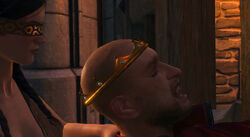
Sometime later on, while his ship was anchored in Novigrad, Radovid was approached by many others claiming to know where Philippa was, but seeing through these lies, he dealt brutal punishments to the deceivers, from having them blinded, their tongues and fingers cut off, or drowned. Geralt subsequently approached him, claiming to have found her location: St. Gregory's Bridge. After being provided proof in the form of Vizimir's ring, which Philippa had used to pass decrees in the late king's name, Radovid and his soldiers set off for the bridge at once.
However, the king turned on the witcher, claiming that he irritated him, and ordered his men to kill him. The witcher was ultimately saved by the timely arrival of Temerian guerrillas, who ambushed the area and thusly caused Radovid to flee. At the last house, the monarch banged on the door to open up, but was stunned when Philippa opened the door to greet him; the sorceress then proceeded to blow powder in Radovid's face, blinding him and leaving him in agonizing pain, before she thrusted a dagger in his back, killing the king.[5]Legacy
A beverage known as Redanian Herbal was called "stern" in honor of Radovid.[7]
The Witcher
Associated quests
The Witcher 2: Assassins of Kings
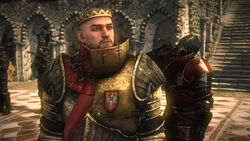
Journal entry
- When Radovid's father, Vizimir II, had fallen victim to an assassin a few years earlier, the prince had had but thirteen summers. The country fell into chaos, as usually happens in such circumstances, and queen Hedwig would not have been able to control things. The aristocracy, as they tend to, started to organize themselves into factions, attempting to tear something out for themselves. Some practically licked the boots of Nilfgaardian emissaries, doing so with much practice and a real sense of commitment. The Regency Council appointed to save the kingdom from the conflict managed to do so, and properly hung the traitors, yet its members disregarded their underage ruler. Therefore nobody among the Redanian nobles expected that Radovid would grow up to become a firm monarch who would repay all humiliations he and his mother had suffered during the regency. The king was quick to show that, if his father had earned the moniker of"the Just", he would be remembered by history as "the Stern".
- If Geralt chooses Iorveth's path during the end of chapter I:
- The sorceress Philippa Eilhart had the dubious pleasure of seeing the aptness of Radovid's moniker with her own eyes, so to speak. After presenting her with a list of charges, reinforced with personal animosity and information from the Imperial envoy, the king had her eyes put out. You might say that Radovid couldn't turn a blind eye to her sins.
- Even before Geralt related his impressions of the discussion with Radovid to me, I already had an feeling that it would be best to avoid attracting the Redanian monarch's interest to my modest self. When Geralt ended up in his dungeon, the king unhesitatingly provided him with a list of arguments detailing why it was in Redania's national interest that the future be deeply unpleasant for the witcher and Triss. He did point out, however, that it was nothing personal.
- Unlike the proud and sometimes self-centered Foltest, or the fitful, coarse Henselt, the king of Redania was a reserved, calculating politician. Geralt learned that he was not the sort of man that would allow himself to be deceived or led astray by prevarication. The king could instantly sense falsehoods and was gifted at maneuvering his opponents into revealing whatever information he desired.
- Radovid had very specific plans concerning his neighbor, the chaos-riddled Temeria. With the prospect of another war against Nilfgaard looming, he and the Kaedweni monarch aimed to partition Temeria in order to forestall the Empire from acquiring its lands.
- If Geralt chooses Roche's path during the end of chapter I:
- Radovid wanted to use Geralt to recover Anaïs La Valette, King Foltest's youngest child. Although she was oblivious to the fact, the girl was a trump card in a high-stakes game. The prize: Foltest's legacy.
- If Geralt chooses to give Anaïs La Valette to him:
- Radovid had very specific plans concerning his neighbor, the chaos-riddled Temeria. In this situation Fate, embodied by a certain witcher and a military captain, had delivered Anaïs La Valette, Foltest's illegitimate daughter, into his hands. Thus the Redanian king had a strong argument that Temeria should be acknowledged a Redanian protectorate. Thanks to skillful political maneuvering, Radovid greatly strengthened himself and his kingdom's position.
- If Geralt chooses to give Anaïs La Valette to John Natalis:
- Radovid had very specific plans concerning his neighbor, the chaos-riddled Temeria. Yet Fate, embodied by a certain witcher and a military captain, had delivered Anaïs La Valette, Foltest's illegitimate daughter, into the hands of Temeria's regent, John Natalis. Radovid would have to find some other way to expand his dominion.
The Witcher 3: Wild Hunt
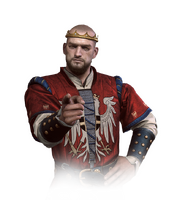
Journal entry
- It did not take long for King Radovid of Redania to prove himself a hard and ruthless ruler, one fully deserving to be styled "the Stern." His father, King Vizimir, was murdered when Radovid was quite young, and his mother, Hedwig of Malleore, and a Regency Council ruled in his stead.
- Young Radovid soon seized power in his own right, however, and wrought vengeance on those who had treated him with disrespect. He took to forcing all his potential political opponents to swear allegiance – or face death.
- He waged war not only against Nilfgaard, but also against mages, whom he saw as the root of all evil. Radovid also made every effort to gain control over the Free City of Novigrad, whose fleet and treasury could tip the scales of the ongoing conflict towards Radovid's victory.
- Geralt's meeting with Radovid confirmed the rumors circling around the king's mental state. The Redanian king was a dangerous madman trapped in his own world of disturbing visions. This did not make him one jot less intelligent or cunning, however.
- Despite his mental afflictions, the young king was manipulating his opponents like an adroit puppet master.
- Radovid burned with particularly intense hostility (first kindled in his earliest childhood days) for the sorceress Philippa Eilhart. Rumors spoke of how he had prepared a special torture regimen just for her - and while the two dozen points they mentioned were surely an exaggeration, they accurately conveyed the general scale of his hatred.
- If Geralt completes Reason of State:
- The terror of Radovid's reign had led not just enemies, but also his allies and even his subjects to long for his death.
- The phrase "monster in human flesh" fit Radovid the Stern perfectly. Perhaps it was awareness of all the cruel and bestial acts this madman perpetrated that led the witcher to get involved in the plans for his assassination.
- Hatred for Philippa Eilhart proved to be Radovid's weakness. He was ready to do anything to capture her - even abandon the safe confines of his flagship.
- The plan for luring Radovid out of hiding worked, though not without complications. Irritated by Geralt's typical cheek, Radovid brayed for the witcher's blood, and Geralt only dodge the executioner's axe thanks to the intervention of his co-conspirators.
- Perhaps the delay this caused was what allowed the ruler to nearly escape his assassins, but in the end he could not cheat fate and died at the hands of Philippa Eilhart, who descended suddenly, a veritable demon of vengeance, to revenge the wrongs he had done her.
Associated quests
Gwent: The Witcher Card Game
Radovid has a number of leader skins and a legendary card.
Iron Judgment reward tree
- Chest: They say Radovid was a gentle boy, friendly and as rambunctious as any other child. But then Philippa Eilhart, the court sorceress, became his tutor. Tales of what she did to the young prince make one's blood run cold. How much truth there is to these stories, no one knows. What is known is that when Radovid ascended to the throne he was a different man. He no longer smiled, and his iron-clad hand was always curled into a fist.
Trivia
- Radovid has the face of Michał Madej, chief designer of The Witcher.
- Radovid's name can be translated as "A joyful sight" (RADOst - Joy, and VID - Look, Appearance)
Notes
- Although Radovid is 2 years younger than Ciri, he looks much older than her in The Witcher 3. A possible explanation for this is that, because time flows differently in other worlds (as Geralt explains in The Witcher 2), Ciri's age may be distorted slightly. Radovid could have also aged quicker due to the stress of war.
- Despite the possibility to kill Radovid in the game, Redanian soldiers can still be heard exclaiming "Long live Radovid".
Videos
Gallery
Footnotes
- ↑ Depending on choices made in The Witcher
- ↑ Depending on choices made in the first two games
- ↑ This detail comes from dynastic descriptions and the ages of the children appear off when put in the context of the Saga (Cintra had already fallen by the time Ciri was 12). In The Tower of the Swallow, Geralt mentions that Queen Calanthe had marriage plans regarding Ciri at some point, but can't remember if it was with Tankred Thyssen or Radovid.
- ↑ 4.0 4.1 Though not explicitly stated in The Witcher series, there are huge hints to Philippa being behind the assassination by the end of The Lady of the Lake. The final confirmation comes from 2001 Polish fan interview with Andrzej Sapkowski.
References
- ↑ 1.0 1.1 CD PROJEKT RED's The Witcher franchise
- ↑ 2.0 2.1 2.2 The Lady of the Lake
- ↑ 3.0 3.1 Time of Contempt
- ↑ Baptism of Fire
- ↑ 5.0 5.1 5.2 5.3 The Witcher 3: Wild Hunt
- ↑ Redanian Dynasty - Radovid V
- ↑ 7.0 7.1 7.2 7.3 The Witcher
- ↑ 8.0 8.1 8.2 8.3 8.4 8.5 The Witcher 2: Assassins of Kings
- ↑ 9.0 9.1 9.2 9.3 9.4 9.5 9.6 Gwent: The Witcher Card Game
- ↑ A Fractured Land: Tales of the Northern Realms
- ↑ The Witcher Role-Playing Game
- ↑ 2nd Edition of Wiedźmin: Gra Wyobraźni
External links
 See the GWENT standalone game version card: Radovid
See the GWENT standalone game version card: Radovid





